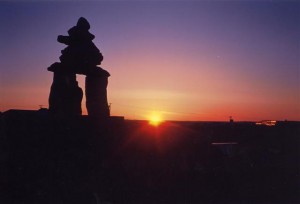[youtube]https://www.youtube.com/watch?v=kQSknLrmRoU&feature=player_embedded[/youtube]
Nanisiniq: Arviat History Project
This website is an excellent example of indigenous Inuit attempting to preserve their own culture themselves, through the use of technology. They have used Tumblr to post their work. There are a great number of images and videos, lots of multimedia, used on the website. Interestingly, their work is done in conjunction with some UBC faculty and graduate students.
In their own words, here is what the Arviat History Project is all about:
‘The Nanisiniq Arviat History Project is a joint venture involving youth and Elders in the Inuit community of Arviat, located on the southwest side of Hudson Bay, Nunavut. The project is co-ordinated in Arviat by Tamar Mukyunik and by Professor Frank Tester of the School of Social Work, University of British Columbia.
For decades, Inuit Elders have expressed concern about the knowledge Inuit youth have of their own social history and culture. This project brings together Inuit youth and Elders in an exploration of their history and culture from an Inuit point of view. The progress of the project and the insights and discoveries of Elders and youth are documented on this website. Elders and youth are also filming their experience and interviewing, not only Elders in their community, but Qablunaat who came north in the late 1950s and 1960s, a period of phenomenal change among Aviarmiut.
In about 10 years the Inuit of Arviat went from tents and igloos, land-based camps and a predominantly hunting culture, to living together in the settlement originally known as ‘Eskimo Point’ and now called Arviat. This is possibly the fastest rate of change for any group of Indigenous people, anywhere in the world, in all of recorded history. The impacts on culture, physical and mental health, social relations and well-being have been dramatic.
Join us in a journey of discovery, documented by Inuit youth, Elders and researchers on this website.’
Mutna,
Team Nanisiniq

